Flexural Deformity - Donkey
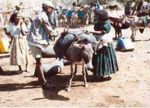
Distal interphalangeal joint flexural deformity
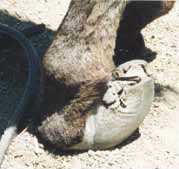
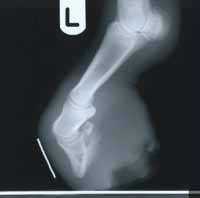
Flexural deformity of the distal interphalangeal joint is seen in donkeys. In the UK it is usually recognised in young rapidly growing animals on a relatively high plane of nutrition and may have the same multifactorial aetiologies as in the horse. Working donkeys overseas also suffer the condition – often in such a severe form that the dorsal hoof wall becomes parallel to the ground surface. In these cases, overwork, concurrent distal limb pain and nutritional deprivation may play a role.
Clinical signs
As in the horse, the deformity may be referred to as:
- Stage 1, where the dorsal hoof wall has not passed the vertical
- Stage 2, where the dorsal hoof wall has passed the vertical
Diagnosis
Donkey foals and young stock should have their hoof-pastern-axis (HPA) regularly assessed on a firm surface.
Treatment
Those that are starting to show flexural deformity should have the plane of nutrition reduced and conservative treatment measures instituted. These measures include rasping the heels to restore a normal HPA and possible application of corrective glue shoes to protect the toes from excessive wear.
In cases where a Stage 2 deformity is present, surgery is required to correct the defect.
Surgery
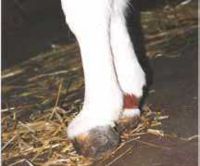
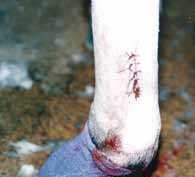
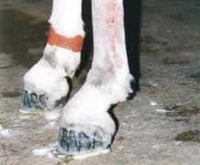
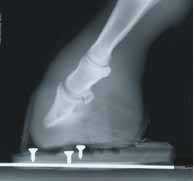
Pre-operatively, radiographs should be taken to assess the distal phalanx; degenerative changes reduce the likelihood of a good outcome. The degree of tension and any abnormal thickening or pain in the flexor tendons should be assessed. At The Donkey Sanctuary we like to arrange for a skilled farrier to be present during the assessment and subsequent surgery. This enables the farrier to be able to apply glue-on shoes while the donkey is still slightly sedated. If more than one limb is to be operated on, front limbs can be operated on with a two-week delay between surgeries, or a fore limb and contra-lateral hind limb may be operated on simultaneously, with a two-week gap for the opposing limbs.
There are three sites for performing the surgery, the simplest being tenotomy of the deep digital flexor tendon (DDFT) in the mid-cannon. This can be performed in the standing animal under sedation and local anaesthetic. This operation results in a pasture-sound animal, and even working donkeys have performed acceptably after the surgery. There is, however, thickening and scarring in the mid-cannon area.
DDFT tenotomy can also be performed in the mid–pastern. In this site the tendon sheath is penetrated and the operation must be carried out under general anaesthetic. A better cosmetic result is obtained, but problems can occur if the cut tendon recoils within the sheath.
Desmotomy of the accessory ligament of the DDFT is the third method of surgical treatment. again this requires general anaesthesia. This technique is only really suitable for Stage 1 deformities. In the donkey an extra head on the accessory ligament may reduce the effectiveness of this surgery (N. Matthews, personal communication).
Tenotomy of the DDFT in the mid-cannon site
This can be performed in the standing, sedated donkey. For analgesia a subcarpal nerve block is used and/or local skin infiltration. The leg is clipped and prepared aseptically. A small skin incision is made on the lateral aspect of the limb at the mid-metacarpal level. The tendons are identified manually and curved artery forceps used to separate the DDFT from the superficial digital flexor tendon (SDFT). Care must be taken to avoid the blood vessels and nerves coursing laterally. A tenotome is inserted into the DDFT and turned through 90º so that the DDFT is divided. At this point a significant gap should appear and the tendon can be checked for complete severance. The subcutis and skin is sutured routinely and the leg bandaged. Phenylbutazone is administered post-op for five to seven days.
After this procedure, the farrier can apply a shoe with a toe extension to help in realigning the HPA. Although theoretically over-extension of the hoof could occur, in practice we have not experienced this.
The donkey should have box rest for 10 to 14 days, then restricted exercise, depending on its temperament. If they are not restricted, young boisterous animals can over-exercise and delay healing of the tendon, while sensible animals may heal adequately on paddock rest.
References
- Thiemann, A. (2008) Surgery In Svendsen, E.D., Duncan, J. and Hadrill, D. (2008) The Professional Handbook of the Donkey, 4th edition, Whittet Books, Chapter 16
For more details on this condition in the donkey, the following references are suggested:
- Carmona, A.G., Sevilla, M.A.T., Sevilla, H.C., and Cabanas, A.L. (1997). ‘Correccion de la contraccion del tendon flexor profundo por medio de un herraje ortopedico en equidos’. Vet.Mex. 28 (2). pp175-177.
- Daniels, L.E., Conine, T.A., and Jackson, D.A. (1990). ‘A rehabilitation team approach to correct flexural deformities in a donkey foal’. Canadian Veterinary Journal 31. pp 297-299.
- Walmsley, J.P. (1995). ‘Flexural deformities of distal interphalangeal joints in a group of young donkeys’. Equine Veterinary Education 7(1). pp 4-6.
Literature Search

|
Use these links to find recent scientific publications via CAB Abstracts (log in is required unless accessing from a subscribing organisation except for full text articles). |
Flexural deformities in donkeys publications
|
|
This section was sponsored and content provided by THE DONKEY SANCTUARY |
|---|